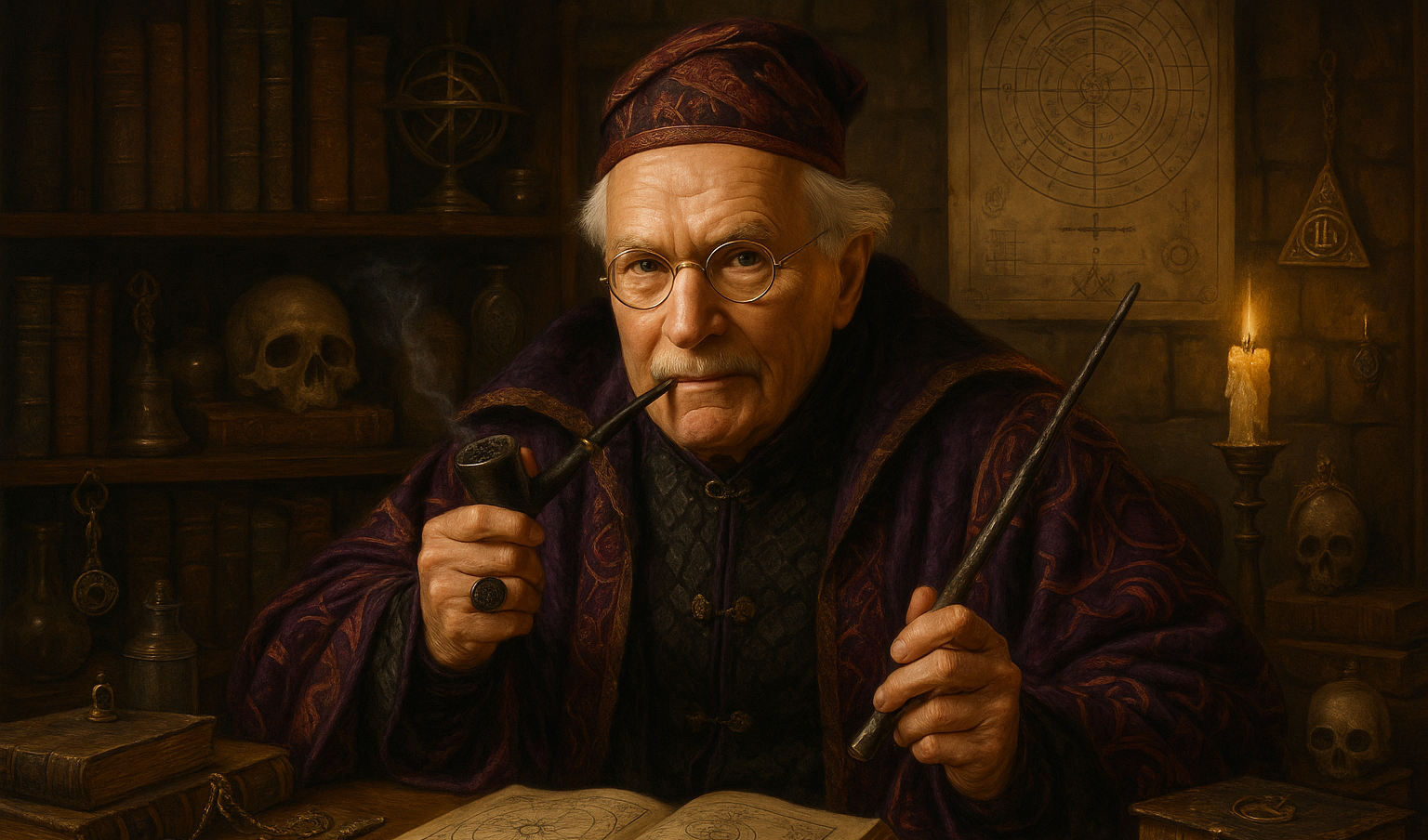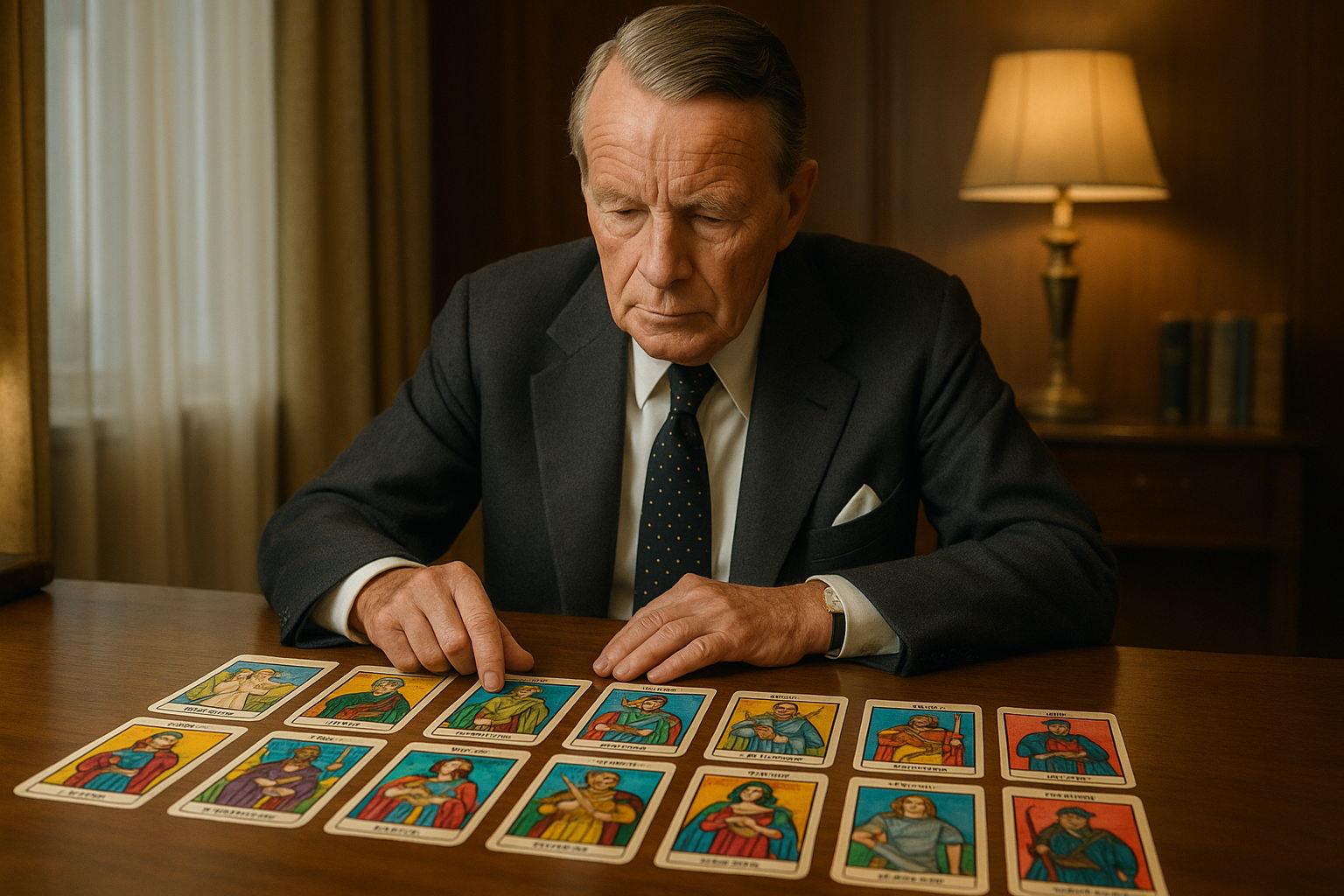The Jungian Industrial Complex: How a Crazy Swiss Psychiatrist Built the $11 Billion Branding Machine
The man. The myth. The archetype.
I was playing around the other day and I started to imagine Jung’s archetype as tarot cards. Like Tarot cards, the Archetypes are the best kind of woo (and I love as bit of woo-woo every now and again) in that they help us make connections and think in creative ways. But are brand archetypes for real, or are they just something you do in a brand workshop?
Brand archetypes work because they hack the oldest operating system in human history—our tribal pattern recognition software. While this psychological framework drives billions in revenue and measurably increases customer engagement, it’s built on the theories of a guy who admitted he felt like he was living in an “insane asylum of his own making.” But the real kicker? B2B brands need this emotional voodoo even more than consumer companies, because nothing says “rational business decision” like buying enterprise software because it makes you feel like a hero.
The Couch Where It All Started
Let’s start with the origin story, because it’s absolutely wild. In 1912, Carl Jung—a Swiss psychiatrist who collected ancient artifacts and talked to his patients about their dreams—had a spectacular professional breakup with Sigmund Freud. While Freud was obsessed with everyone wanting to sleep with their mothers, Jung went deeper: he argued we’re all carrying around the same psychological software, installed at the factory.
Jung called this the “collective unconscious”—basically, humanity’s shared psychological hard drive loaded with the same character archetypes across every culture. The Hero. The Wise Old Man. The Trickster. The Mother. These weren’t just stories; they were the fundamental organizing principles of human psychology. They show up in everything from Gilgamesh to the Bible to Apple ads.
Here’s where it gets interesting for anyone trying to sell stuff: Jung’s archetypal patterns bypass rational thought entirely, creating immediate emotional recognition without requiring conscious processing. It’s like having a master key to the human psyche.
The marketing world didn’t catch on immediately. It took Joseph Campbell’s 1949 The Hero with a Thousand Faces to translate Jung’s psychiatric insights into narrative gold. Campbell showed that every culture tells the same basic stories—the farmboy who becomes a king, the journey into darkness and back to light. George Lucas used Campbell’s framework to create Star Wars, grossing $10+ billion and proving that archetypal storytelling could literally print money. In fact, the Hero’s journey is practically corporate policy at Disney.
But the real translation happened in the 1990s when Carol Pearson and Margaret Mark systematized Jung’s insights into The Hero and the Outlaw, giving marketers a practical toolkit. Suddenly, every brand could have a personality that tapped into millions of years of human evolution.
Why This Psychological Warfare Actually Works
The numbers don’t lie, and they’re staggering. Research shows 94% of purchasing decisions happen subconsciously, with archetypal brands demonstrating up to 40% increases in customer engagement. Nielsen data confirms that brands using archetypal positioning achieve 35% greater campaign effectiveness and 30% marketing efficiency gains.
Think about it: your brain processes 11 million bits of information per second, but your conscious mind can only handle about 40. Archetypes work because they operate in the subconscious processing layer, creating instant pattern recognition that feels like “knowing” rather than “thinking.” It’s like data compression for storytelling.
This isn’t manipulation—it’s recognition. When Nike positions itself as the Hero archetype, they’re not creating artificial desire; they’re identifying with the part of you that wants to overcome challenges. When Apple evolved from The Rebel (1984’s rebellion against IBM) to Creator (Think Different) to Magician (making technology disappear), they were mapping to different aspects of human motivation.
The most brutal example? Marlboro’s transformation from a women’s cigarette to the ultimate masculine brand through cowboy imagery increased sales 300% in two years—from $5 billion to $20 billion. That’s the power of archetypal repositioning, even for a product that literally kills you.
The Dark Side of the Archetypal Force
But here’s where I get skeptical, because nothing this powerful comes without downsides.
First, the theoretical foundation is shaky as hell. Jung developed archetype theory while acknowledging he felt like he was living in an asylum. Marketing veteran Marty Marion points out that expanding from Jung’s original four archetypes to marketing’s twelve represents “arbitrary categorization without scientific justification.” We’ve built a billion-dollar industry on the psychological insights of a guy who was questioning his own sanity. That’s why I regard it as woo-woo—culturally useful woo-woo, but woo-woo nonetheless.
Second, the cultural bias is profound. Try visualizing the typical Hero, Ruler, Explorer, or Magician archetype. Research consistently shows these archetypes evoke predominantly male imagery, while Lover, Caregiver, and Innocent archetypes are associated with “dainty pictures of naive or devoted women.” This reflects what scholars trace back to Aristotelian foundations—basically, we’re using the philosophical frameworks of “a renowned misogynist who believed women weren’t fit to contribute to society.”
Third, cross-cultural translation fails spectacularly. Academic research comparing Chinese and Western cultural archetypes found fundamental differences in social structure formation and mythological characters, concluding that Western archetypal frameworks aren’t suitable for Chinese brand identification. As brands become global, archetypal thinking becomes provincially Western.
Finally, and most damaging: archetypal branding can create strategic myopia. It’s “all about your brand, and not at all about how your brand solves your consumers’ problems or pain points, in ways that your competitors don’t or can’t.” This is inside-out thinking when the most successful companies obsess over customer needs. Don’t confuse aspiration with credibility: just because you want to be a hero doesn’t mean others see you that way. Sometimes the Archetype can be an aspiration more than a reflection. And when that happens, your brand feels inauthentic.
B2C vs B2B: The Emotional Divide That Isn’t
Here’s where conventional wisdom gets it completely wrong. The traditional narrative: B2C buyers are emotional and irrational, while B2B buyers are logical robots who make spreadsheet-driven decisions.
Bullshit.
B2B buyers are still humans with emotions, preferences, and values that affect their decisions. According to Google and CEB research, B2B buyers are 50% more likely to purchase from a brand that appeals to their personal values than from one that only provides functional benefits.
The real differences are structural, not psychological:
Transaction Characteristics: B2C purchases are typically low-cost, high-frequency, individual decisions made quickly. They are also driven by a small number of people—an individual or a single household. B2C brands need to create memorable moments that drive impulse or habitual purchasing. B2B purchases on the other hand, are high-cost, low-frequency, committee-driven decisions with long sales cycles. B2B brands need to build trust over months or years while appealing to multiple stakeholders.
Relationship Dynamics: B2C branding is transactional rather than relational—even when sold through salespeople, the relationship is very short-term and often one-time. The brand power is in its ability to serve as a signal to others. B2B branding is all about building relationships, with products sold through direct interaction and ongoing support.
Risk Profiles: B2C customers risk embarrassment, buyer’s remorse, or wasted money. B2B customers risk their careers, company performance, and professional reputation. B2B customers purchase based on longer-term calculation of risk and reward, while B2C customers purchase more on emotion and convenience.
But to paraphrase David Ogilvy: “The B2B customer is not a job title. She is your wife.” The same people who buy enterprise software, consulting services, or industrial equipment also buy beauty products, clothes, and groceries. They have essentially the same emotions, connect in similar ways, and want to interact similarly whether buying B2B or B2C products.
Why B2B Brands Need This Shit More Than Anyone
This is where it gets counterintuitive. B2B brands actually benefit more from archetypal positioning than consumer brands, for three brutal reasons:
1. Commoditization Hell: B2B markets are ruthlessly efficient at driving products toward commodity status. When your enterprise software, consulting services, or industrial equipment becomes indistinguishable from competitors, archetypal positioning creates the only sustainable differentiation. In today’s hyper-digital landscape, connection is currency. Attention spans are short, expectations are high, and brand differentiation has never been harder.
2. Decision Committee Dynamics: B2C purchases involve one or two people. B2B purchases involve procurement, finance, IT, end-users, and C-suite executives—all with different priorities and risk tolerances. Your brand needs to appeal to a wide range of stakeholders in different jobs who all have different criteria for the purchase. Archetypal positioning provides shared emotional language that works across functional silos.
3. Career Risk Amplification: When a B2C purchase goes wrong, you’re out some money. When a B2B purchase goes wrong, you might be out a job. B2B decision-makers don’t just buy solutions; they buy safety, security, and confidence in their professional judgment. Archetypal brands provide psychological cover: “Nobody gets fired for buying IBM” isn’t about technology—it’s about the Ruler archetype providing institutional safety.
Consider the archetypal approaches:
Salesforce as the Trailblazer (Explorer): They don’t sell CRM software; they sell the journey to customer success. “Trailhead” isn’t just training—it’s archetypal positioning around exploration and discovery.
IBM as the Sage: “Think” isn’t a tagline; it’s archetypal positioning around wisdom and deep knowledge. When enterprises buy IBM, they’re not just buying technology—they’re buying the archetypal promise of institutional wisdom.
Slack as the Everyperson: They took workplace communication—historically dominated by enterprise giants—and positioned it as friendly, approachable, and human. The bird logo, playful language, and “Where work happens” messaging appeals to the Everyperson archetype in ways that Microsoft Teams never could.
The Future: Beyond Archetypal Orthodoxy
The most successful brands—B2B and B2C—are evolving beyond single-archetype thinking. Recent research suggests successful brands actually leverage multiple archetypes rather than the traditional single-archetype approach. Netflix combines Creator (original content), Magician (recommendation algorithms), and Everyperson (accessible entertainment). Amazon embodies Creator (marketplace platform), Magician (logistics), and Caregiver (customer obsession).
The future isn’t about choosing your archetype; it’s about orchestrating archetypal complexity that matches your actual value proposition. Alternative frameworks like Jobs-to-be-Done examine what customers are trying to accomplish rather than archetypal characteristics, leading to 86% success rates in product development.
Smart brands use archetypal insights as psychological foundation, not strategic constraint. They understand that humans need pattern recognition and emotional connection, but they don’t let twelve categories from a century-old psychiatric theory limit their actual business strategy.
The Uncomfortable Truth
Here’s what the branding consultants won’t tell you: archetypal branding works despite its flawed theoretical foundation, not because of it. The framework succeeds because it forces brands to develop a consistent personality and emotional positioning, not because Jung’s collective unconscious theory is necessarily scientifically valid.
The billion-dollar archetypal industry exists because it provides useful scaffolding for brand thinking, particularly in B2B markets where emotional differentiation seems counterintuitive but is actually more crucial than anywhere else. The companies that win understand archetypal insights as tools, not dogma—ways to tap into human psychology without being constrained by arbitrary categorization.
The bottom line: Use archetypal thinking to understand human motivation, but don’t let it replace understanding your actual customers’ actual problems. Jung’s insights into human psychology remain powerful; his specific archetypal framework less so. The brands that succeed combine archetypal emotional intelligence with rigorous customer-centric strategy. The choice of a brand archetype is less important than making sure the touchpoints you create are consistent with your archetype.
Because at the end of the day, whether you’re selling smartphones or enterprise software, you’re selling to humans. And humans—even the ones wearing suits and making “rational” business decisions—are still running on psychological software installed over millions of years of evolution. Archetypes hack that software. Just don’t mistake the hack for the whole system.













